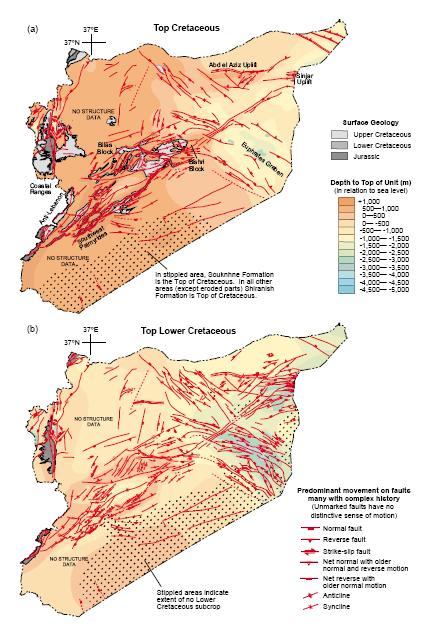
For the past twelve years, Cornell Syria Project scientists have jointly collaborated with their colleagues at the Syrian Petroleum Company to study the regional structure and geologic evolution of Syria. We are currently generating new structural maps and tectonic models for the whole country. Information on this region is relatively limited, despite the local importance of hydrocarbon production and abundant surface and subsurface data. Our regional approach involves new interpretations of seismic reflection profiles, well data, remote sensing imagery, and potential field data, merged together with existing interpretations of similar data sets. These interpretations, integrations, analyses, and map preparation, are all being performed within a GIS platform.
Our interpretations show that much of the tectonic deformation within Syria has occurred within repeatedly reactivated 'mobile zones'. GIS-generated structural maps on various geologic horizons, and tectonic maps at key time points, illustrate the interconnected and contemporaneous nature of the tectonic episodes within the different Syrian mobile zones. Hydrocarbon plays in Syria, such as the Euphrates Fault System, owe their existence to these tectonic episodes; a better understanding of the deformation will lead to more informed exploration strategies. Hence, the data stored within the GIS can be used to directly influence exploration strategies and decisions.
Click here to view the complete published PDF version of this paper
Figure 12.
Maps of Syria showing depth, structure, and stratigraphy of various subsurface geologic horizons derived from seismic and well data. Colors in each map represent best estimates of depths to chosen horizon, black contours indicate extents of uppermost subcropping formation of the chosen horizon, and faults and folds are marked in red. Surface geology modified from Ponikarov (1966). Surfaces shown are (a) top Cretaceous, (b) top Lower Cretaceous, (c) top Triassic, (d) top Paleozoic (see Figure 8). In (a) only two different formations subcrop, except in exposed areas. Therefore, a stippled pattern is used to show where the Soukhne formation subcrops, and the Shiranish formation subcrops in all other areas. There is only one Lower Cretaceous formation, therefore in (b) the stippled pattern indicates an absence of the Lower Cretaceous. The Lower Cretaceous is present in all other areas.

